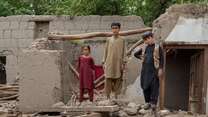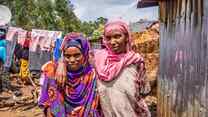Refugee Compacts: Addressing the Crisis of Protracted Displacement
Final Report of the Forced Displacement and Development Study Group
The disruptive “new normal” of displacement
Today’s refugee crisis poses serious challenges to the international order. Conflict and crisis have pushed some 21 million people to seek refuge outside their home countries, including 5 million who have fled Syria since the civil war began in 2011. Approximately 76 percent of refugees live outside of camp settings, making it even more difficult to locate and reach them with essential services. Furthermore, protracted displacement has become the “new normal.” Refugees now spend an average of 10 years away from their homes, and for refugees displaced more than five years, the average is 21 years.
Low- and middle-income countries host a staggering 88 percent of the world’s refugees. The reality of refugees striving to rebuild their lives alongside host communities can fuel divisive politics, and the strain of refugee flows can threaten hard-won development gains. Refugees often have limited access to jobs, education, and the basic protections and freedoms required to rebuild their lives. Insufficient support from the international community for both immediate and longer-term recovery can beget further crises, as countries close borders, force returns, and detain those flee- ing violence and insecurity. Despite the political turmoil precipitated by forced displacement, this is an eminently manageable challenge for the global community. Refugees comprise less than 0.3 percent of the global population, and the vast majority is geographically concentrated in a handful of frontline states.
Time for a new approach
A different approach is possible. The scale and urgency of the refugee crisis presents a window of opportunity for donors, humanitarian and development agencies, host countries, the private sector, and civil society to forge new partnerships that give refugees and host communities a chance to thrive together. Evidence shows that when policies and programs promote refugees’ self-reliance and integration into host countries’ development plans, the short-term costs are outweighed by refugees’ longer-term economic and social contributions. And while much needs to change about current humanitarian and development silos, financing and coordination structures, and the role of host governments, promising developments can be seen at the national, regional, and international levels.
Perhaps the most important development was the launch of large-scale humanitarian-development partnerships in 2016, such as the Grand Bargain, signed at the World Humanitarian Summit, as well as significant financing initiatives. The World Bank, the Islamic Development Bank Group, and other partners created the Global Concessional Financing Facility to provide concessional financing to middle-income countries hosting large refugee populations; and the World Bank launched a financing window in the record-breaking IDA-18 replenishment, providing up to US$2 billion in grants and concessional loans to low-income countries to meet the development needs of refugees and host communities. The engagement of development actors like the World Bank represents a step-change in how the international community responds to protracted displacement. Missing from these critical initiatives, however, is a clear road map for overcoming the challenges of the current fractured response to displacement.
Refugee Compacts: an innovative solution
Compact agreements have emerged as a new approach, bringing together donors and development and humanitarian actors under host-country leadership for multiyear agreements to achieve defined, sustainable outcomes for refugees and host communities. Under a compact framework, diverse actors make mutually reinforcing commitments to resources, policy changes, and projects designed to achieve a shared vision. Three features make the compact model uniquely suited to address today’s refugee crisis:
- Compacts systematically gather humanitarian and development expertise under the umbrella of host-country leadership and a set of shared outcomes. They put host govern- ments in the lead on long-term solutions for refugees, a population which does not fit within the traditional state-citizen relationship.
- Compacts use a common analytical and results framework and a set of process requirements that support evidence-based decision-making and build consensus around the resources, policy changes, and projects required to achieve results. The standardization of the process requirements helps depoliticize difficult negotiations over the right mix of programs and policy changes.
- Compacts strengthen incentives for policy reforms by bringing together diverse actors and financing mechanisms in multiyear agreements focused on measurable results.
While not appropriate in every refugee context, compacts are already driving progress in several places. The most prominent examples are in Jordan and Lebanon, where the World Bank has partnered with host governments and other actors to improve livelihoods and education outcomes, respectively. The lessons of these early compacts, as well as compact experiences in other contexts, offer key insights for humanitarian and development partners working to refine, expand, or launch initiatives to support low- and middle-income countries hosting refugees, including the Global Concessional Financing Facility and the IDA-18 sub-window, the European Union Migration Part- nership Framework, and the Education Cannot Wait fund.
10 recommendations for meeting the Long-term needs of refugees and Host Communities
The Center for Global Development and the International Rescue Committee convened a joint study group to assess how key lessons from recent humanitarian-development collaborations can inform a sound partnership framework between host governments, development and humanitar- ian actors, the private sector, and civil society in protracted displacement situations. While our recommendations can inform a variety of partnership arrangements, well-designed compacts hold the greatest potential for meeting the complex challenges of protracted displacement.
We urge policymakers to focus on three key principles and 10 recommendations to design effective compacts:
Principle 1. Balance the needs of refugees and host communities, with a focus on key policy constraints. Better identification and prioritization of the policy changes needed to achieve desired collective outcomes could accelerate progress. Further, interventions should be more responsive to the needs and circumstances of refugee and host communities, with strategies that incorporate short-, medium-, and long-term actions that respond to immediate needs while they strengthen foundations for a sustained response. Breakdowns in this balance often result from gaps in initial analyses and assessments as well as inconsistent participation of the full range of stakehold- ers throughout the program cycle.
To put this principle into practice, partners should:
- Develop and use standardized assessment tools that identify barriers to achieving shared outcomes. Such assessments should begin with identifying expected key outcomes, grounded in a common theory of change, and they should determine the key pathways to achieving results for both refugees and host communities, including necessary policy changes.
- Create a refugee policy index that evaluates key country policies and the legal, physical, and material status of refugees relative to host communities. A universal framework would increase transparency, highlight critical areas for reform, and motivate change to better meet the needs of refugees and host communities.
- Take a portfolio approach that balances short- and long-term interventions and the needs of refugees and host communities, using common decision-making criteria that assess, for example, timing to impact, proportion of target population to be reached, cost-effectiveness, and distribution of benefits to female and male beneficiaries.
- Create structures for inclusive stakeholder engagement, with host governments in the lead, and include humanitarian and development stakeholders from humanitarian and development sectors, impacted constituencies, the private sector, and civil society. Multi-stakeholder governing boards chaired by host governments show promise.
We encourage the World Bank and the United Nations High Commissioner for Refugees (UNHCR), in collaboration with partners and building on best practices, to develop a core set of assessment tools and guidance. Financing platforms should require the use of appropriate assessment tools and guidance on portfolio criteria and stakeholder engagement.
Principle 2. Improve data, evidence, and innovation to drive outcomes and get the most value for money. Our assessment identified significant data-related challenges, including information gaps and a lack of protocols, frameworks, and incentives for sharing data across agencies and host countries. Financial data remains siloed and lacks transparency, hindering collective planning efforts. There are also gaps in the evidence base for effective interventions and a lack of systematic use of evidence where it exists. Measures for cost analyses are not defined or consistently applied. Finally, innovation—critical in this context—is insufficiently rewarded. Addressing these gaps should be a priority to inform decision-making, assess progress, and spend scarce resources wisely.
To put this principle into practice, partners should:
- Improve data collection and availability, including on financing streams, to support decision-making; track progress and outcomes related to interventions focused on refugees and their host communities; and facilitate planning, coordination, and transparency.
- Use and generate evidence to drive programmatic decisions and help depoliticize difficult policy changes, including designating a minimum of 5 percent of program funds for monitoring and evaluation.
- Establish standards for measuring cost-efficiency and cost-effectiveness to ensure value for money and to stretch limited resources for maximum impact.
- Incentivize and fund innovation to help fill gaps in the evidence base and identify new tools and approaches, including reserving flexible funds for rapidly testing and scaling innovative approaches. Specific emphasis should be placed on nontraditional humanitarian partners, such as local governments and the private sector.
To advance these recommendations, donors should support the World Bank, United Nations agencies, and organizations with relevant technical expertise to create a data and evidence alliance that identifies and develops solutions for data and evidence gaps related to refugees and their host communities. To the extent possible, financing platforms should require the systematic assessment of proposed interventions against the existing evidence base and measures of cost-efficiency and cost-effectiveness; they should also publish data on funding as well as other specific markers for tracking Grand Bargain commitments.
Principle 3. Strengthen and align incentives to achieve results. Because they are multi-year agreements among a diverse range of partners, compacts can use beyond-aid approaches to strengthen incentives for action and achieve scale and impact when aid alone is insufficient. Crowding-in financing partners—bilateral donors, multilateral actors, and the private sector—can increase effectiveness, efficiency, coherence, and scale. And disbursing funds on the basis of the completion of process requirements, such as establishing a multistakeholder governance board or a data system, and eventually the achievement of expected results, can further support program effectiveness and accountability.
To put this principle into practice, partners should:
- Pay for results to strengthen incentives and drive progress for both refugees and host com- munities, with a focus on identifying benchmarks for disbursement tied to critical barriers to achieving results and systemic gaps. To the extent possible, there should be a greater emphasis on linking disbursements to outcomes, not just inputs and outputs.
- Increase use of beyond-aid tools and crowd in partners to strengthen incentives for host governments to address legal, policy, and operational barriers; leverage limited aid dollars; reinforce accountability; and move toward shared solutions.



